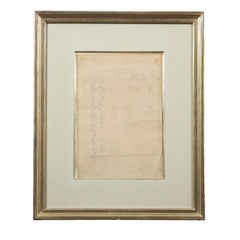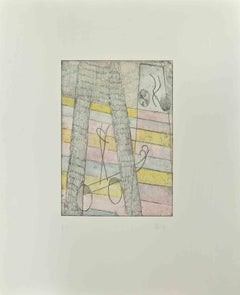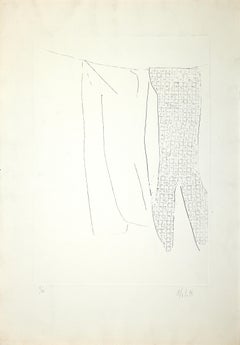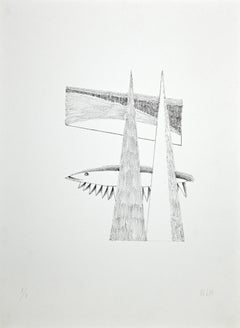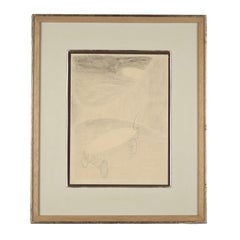Fausto Melotti Art
to
3
8
2
5
8
3
4
1
Overall Height
to
Overall Width
to
4
3
1
1
1
1
8
1
4
10
6,845
3,159
2,517
1,217
3
2
2
1
1
Artist: Fausto Melotti
Sculpture project by Fausto Melotti, 1936
By Fausto Melotti
Located in Milan, IT
Pencil on watermarked paper. Signed lower left. The drawing is accompanied by an authentication on photo from the Fausto Melotti Archive, with code DIS 36 015, showing the data of th...
Category
1930s Contemporary Fausto Melotti Art
Materials
Pencil
Untitled - Etching by Fausto Melotti - 1970s
By Fausto Melotti
Located in Roma, IT
Untitled is a Contemporary artwork realized by the Italian artist Fausto Melotti (Rovereto, 1901 – Milan, 1986).
Etching on paper. Hand signed on the right margin. p.a. edition.
B...
Category
Late 20th Century Abstract Fausto Melotti Art
Materials
Etching
Untitled - Lithograph by Fausto Melotti - 1970s
By Fausto Melotti
Located in Roma, IT
Hand signed and numbered. Edition of 50.
Good conditions.
Fausto Melotti (Rovereto, 1901-Milano, 1986) was an italian sculptor and painter. In his works of art, the link with the ...
Category
1970s Abstract Fausto Melotti Art
Materials
Lithograph
Untitled - Lithograph by Fausto Melotti - 1970s
By Fausto Melotti
Located in Roma, IT
Hand signed and numbered. Edition of 10 pieces in Roman numerals.
Good conditions.
Category
1970s Abstract Fausto Melotti Art
Materials
Lithograph
Untitled - Watercolor - 1977
By Fausto Melotti
Located in Roma, IT
Untitled is an original Contemporary artwork realized by the Italian Contemporary artist Fausto Melotti (Rovereto, 1901 – Milan, 1986) in 1977.
Original Watercolor on paper.
Good...
Category
1970s Fausto Melotti Art
Materials
Watercolor
Untitled - Etching by Fausto Melotti - 1970s
By Fausto Melotti
Located in Roma, IT
Hand signed and numbered. Edition of 50 pieces.
Good conditions.
Image Dimensions: 34,5x24 cm.
Category
Late 20th Century Abstract Fausto Melotti Art
Materials
Etching
Untitled - Original Lithograph by Fausto Melotti - 1974
By Fausto Melotti
Located in Roma, IT
Hand signed and numbered. Edition of only 8 prints in Roman numerals.
Very good conditions.
Category
1970s Contemporary Fausto Melotti Art
Materials
Lithograph
Drawing on paper by Fausto Melotti 1984
By Fausto Melotti
Located in Milan, IT
Tempera, pencil and charcoal on paper. Signed on the back. The drawing is registered in the Fausto Archive with code DIS 84020. Fausto Melotti was a multifaceted and very prolific ar...
Category
20th Century Contemporary Fausto Melotti Art
Materials
Tempera
Related Items
Woman Circus Rider on Red Horse - superb Chagall poster
By Marc Chagall
Located in London, GB
Original lithographic poster printed by L.R.B Permild and Rosengreen.
Category
Late 20th Century Abstract Fausto Melotti Art
Materials
Lithograph
The Abduction of the Sabine Women , a Renaissance drawing by Biagio Pupini
Located in PARIS, FR
This vigorous drawing has long been attributed to Polidoro da Caravaggio: The Abduction of the Sabine Women is one of the scenes that Polidoro depicted between 1525 and 1527 on the façade of the Milesi Palazzo in Rome. However, the proximity to another drawing inspired by this same façade, kept at the Ecole des Beaux-Arts, and to other drawings inspired by Polidoro kept at the Musée du Louvre, leads us to propose an attribution to Biagio Pupini, a Bolognese artist whose life remains barely known, despite the abundant number of drawings attributed to him.
1. Biagio Pupini, a Bolognese artist in the light of the Roman Renaissance
The early life of Biagio Pupini, an important figure of the first half of the Cinquecento in Bologna - Vasari mentions him several times - is still poorly known. Neither his date of birth (probably around 1490-1495) nor his training are known. He is said to have been a pupil of Francesco Francia (1450 - 1517) and his name appears for the first time in 1511 in a contract with the painter Bagnacavallo (c. 1484 - 1542) for the frescoes of a church in Faenza. He then collaborated with Girolamo da Carpi, at San Michele in Bosco and at the villa of Belriguardo.
He must have gone to Rome for the first time with Bagnacavallo between 1511 and 1519. There he discovered the art of Raphael, with whom he might have worked, and that of Polidoro da Caravaggio. This first visit, and those that followed, were the occasion for an intense study of ancient and modern art, as illustrated by his abundant graphic production.
Polidoro da Caravaggio had a particular influence on the technique adopted by Pupini. Executed on coloured paper, his drawings generally combine pen, brown ink and wash with abundant highlights of white gouache, as in the drawing presented here.
2. The Abduction of the Sabine Women
Our drawing is an adaptation of a fresco painted between 1525 and 1527 by Polidoro da Caravaggio on the façade of the Milesi Palace in Rome. These painted façades were very famous from the moment they were painted and inspired many artists during their stay in Rome. These frescoes are now very deteriorated and difficult to see, as the palace is in a rather narrow street.
The episode of the abduction of the Sabine women (which appears in the centre of the photo above) is a historical theme that goes back to the origins of Rome and is recounted both by Titus Livius (Ab Urbe condita I,13), by Ovid (Fasti III, 199-228) and by Plutarch (II, Romulus 14-19). After killing his twin brother Romus, Romulus populates the city of Rome by opening it up to refugees and brigands and finds himself with an excess of men. Because of their reputation, none of the inhabitants of the neighbouring cities want to give them their daughters in marriage. The Romans then decide to invite their Sabine neighbours to a great feast during which they slaughter the Sabines and kidnap their daughters.
The engraving made by Giovanni Battista Gallestruzzi (1618 - 1677) around 1656-1658 gives us a good understanding of the Polidoro fresco, allowing us to see how Biagio Pupini reworked the scene to extract this dynamic group.
With a remarkable economy of means, Biagio Pupini takes over the left-hand side of the fresco and depicts in a very dense space two main groups, each consisting of a Roman and a Sabine, completed by a group of three soldiers in the background (which seems to differ quite significantly from Polidoro's composition).
The balance of the drawing is based on a very strongly structured composition. The drawing is organised around a median vertical axis, which runs along both the elbow of the kidnapped Sabine on the left and the foot of her captor, and the two main diagonals, reinforced by four secondary diagonals. This diamond-shaped structure creates an extremely dynamic space, in which centripetal movements (the legs of the Sabine on the right, the arm of the soldier on the back at the top right) and centrifugal movements (the arm of the kidnapper on the left and the legs of the Sabine he is carrying away, the arm of the Sabine on the right) oppose each other, giving the drawing the appearance of a whirlpool around a central point of support situated slightly to the left of the navel of the kidnapper on the right.
3. Polidoro da Caravaggio, and the decorations of Roman palaces
Polidoro da Caravaggio was a paradoxical artist who entered Raphael's (1483 - 1520) workshop at a very young age, when he oversaw the Lodges in the Vatican. Most of his Roman work, which was the peak of his career, has disappeared, as he specialised in facade painting, and yet these paintings, which are eminently visible in urban spaces, have influenced generations of artists who copied them abundantly during their visits to Rome.
Polidoro Caldara was born in Caravaggio around 1495-1500 (the birthplace of Michelangelo Merisi, known as Caravaggio, who was born there in 1571), some forty kilometres east of Milan. According to Vasari, he arrived as a mason on the Vatican's construction site and joined Raphael's workshop around 1517 (at the age of eighteen according to Vasari). This integration would have allowed Polidoro to work not only on the frescoes of the Lodges, but also on some of the frescoes of the Chambers, as well as on the flat of Cardinal Bibiena in the Vatican.
After Raphael's death in 1520, Polidoro worked first with Perin del Vaga before joining forces with Maturino of Florence (1490 - 1528), whom he had also known in Raphael's workshop. Together they specialised in the painting of palace façades. They were to produce some forty façades decorated with grisaille paintings imitating antique bas-reliefs.
The Sack of Rome in 1527, during which his friend Maturino was killed, led Polidoro to flee first to Naples (where he had already stayed in 1523), then to Messina. It was while he was preparing his return to the peninsula that he was murdered by one of his assistants, Tonno Calabrese, in 1543.
In his Vite, Vasari celebrated Polidoro as the greatest façade decorator of his time, noting that "there is no flat, palace, garden or villa in Rome that does not contain a work by Polidoro". Polidoro's facade decorations, most of which have disappeared as they were displayed in the open air, constitute the most important lost chapter of Roman art of the Cinquecento. The few surviving drawings of the painter can, however, give an idea of the original appearance of his murals and show that he was an artist of remarkable and highly original genius.
4. The façade of the Milesi Palace
Giovanni Antonio Milesi, who commissioned this palace, located not far from the Tiber, north of Piazza Navona, was a native of the Bergamo area, like Polidoro, with whom he maintained close friendly ties. Executed in the last years before the Sack of Rome, around 1526-1527, the decoration of Palazzo Milesi is considered Polidoro's greatest decorative success.
An engraving by Ernesto Maccari made at the end of the nineteenth century allows us to understand the general balance of this façade, which was still well preserved at the time. The frescoes were not entirely monochrome, but alternated elements in chiaroscuro simulating marble bas-reliefs and those in ochre simulating bronze and gold vases...
Category
16th Century Old Masters Fausto Melotti Art
Materials
Ink, Gouache, Pen
Lee Hurst (3/4 Figure, Hands Together), Mixed media on Pergamenata parchment
By Howard Tangye
Located in London, GB
Howard Tangye (b.1948, Australia) has been an influential force in fashion for decades. Lecturing at London’s Central Saint Martins for 35 years, including 16 years as head of BA Wom...
Category
2010s Contemporary Fausto Melotti Art
Materials
Paint, Paper, Parchment Paper, Charcoal, Crayon, Oil Crayon, Oil Pastel,...
Freya (Seated Backwards), Mixed media on grey board
By Howard Tangye
Located in London, GB
Howard Tangye (b.1948, Australia) has been an influential force in fashion for decades. Lecturing at London’s Central Saint Martins for 35 years, including 16 years as head of BA Wom...
Category
2010s Contemporary Fausto Melotti Art
Materials
Other Medium, Archival Paper, Handmade Paper, Pen, Felt Pen, Permanent M...
Gustav Melcher ( German, 1898 -?) Boats off Venice Italy Ink Water Color c. 1918
By Gustav Melcher
Located in Meinisberg, CH
Gustav Melcher
(German, 1898-?)
Segelschiffe vor Venedig - Sailing ships off Venice
• India ink, water colour wash
• Visible image ca. 11.5 x 18 cm
• Glased Frame ca. 20 x 25 cm
• Verso various inscriptions
• Signed lower right
Gustav Melcher was a German painter and a pioneer in film, film criticism and film theory and created this clever little picture of the skyline of Venice with various vessels.
Going by the various inscriptions an the backing paper, this drawing was made in 1918 when Gustav was twenty years old and passed on three years later to Gertrud Melcher on the 1. 2. 1921. I have no reasons to doubt this information. The small drawing is still in its unopened frame, so maybe there is more information to be discovered , however this will be the privilege of the next owner.
The picture also has retained its original antique frame – note that it has lost over the years various sections of the gesso decoration.
The very precisely executed drawing is most enjoyable to look at and doing so, remember you are looking through the eyes of a young man, who saw this foreign sea cape over a century ago.
Thank you for your interest and please note, that I offer free worldwide shipping on all my items.
Gustav Melcher began his studies at the Düsseldorfer Kunstakademie under Peter Janssen and Eduard von Gebhardt. Originaly he was interested in figurative and portrait painting, but after time he decided to pursue the depiction of land- and marinescapes. Durin his studies the young artist undertook trips to visit England, Scotland, Belgium and France and he joined the artist society Malkasten. It was in those days he would hold speeches to his colleges about this new invention called ‘Kintopp’ – Melcher was a great advocate of the moving pictures...
Category
1910s Naturalistic Fausto Melotti Art
Materials
India Ink, Paper, Watercolor
Gustav MelcherGustav Melcher ( German, 1898 -?) Boats off Venice Italy Ink Water Color c. 1918, 1918
Free Shipping
H 7.88 in W 9.85 in D 0.79 in
Abstract print by Joan Miró from "Fusées" portfolio, blue, black, beige
By Joan Miró
Located in Köln, DE
from "Fusées" - Joan Miró, one artwork out of "Fusées" portfolio
Wonderful exemplar form the portfolio "Fusées".
Aquatint etching from 1959
32 x 50 cm. Edition of 100
Category
1950s Abstract Fausto Melotti Art
Materials
Aquatint
Geranium
Located in Llanbrynmair, GB
’Geranium’
By Yutaka Takayanagi.
Medium - Relief and lithographic print
Edition - 5/20
Signed - Yes
Size - 510mm x 660mm
Date - 1978
Condition - Excellent. 10 out of 10.
Born in Tokyo in 1941, Takayanagi's artistic journey began when he enrolled at Tokyo University of the Arts in 1960, studying under the renowned oil painter Kaoru Yamaguchi. His talent was quickly recognized when he received an Honorable Mention at the 8th Shell Arts Award Exhibition in the same year.
During his time at university, Takayanagi took an intensive course in copper plate printing under Tetsuro Komai, receiving his degree from the graduate school in 1966. Fascinated by the simultaneous color print method, he started creating copperplate prints and soon gained recognition for his unique metallic reliefs, which he produced using collages of English newspapers.
Takayanagi's passion for experimentation led him to create metallic emboss reliefs using his own photographs, and in the latter half of the 1980s, he moved on to silkscreen prints. He continued to push the boundaries of his art, constantly exploring new techniques and mediums.
In 1978 and the following year, Takayanagi was appointed as an arts researcher for the Ministry of Culture and traveled to the United States, France, and the UK. These experiences enriched his artistic perspective and further cemented his reputation as a highly regarded artist.
Takayanagi was part of the influential printmaking group Sosaku Hanga, which emerged in the early 20th century in Japan. This movement emphasized the artist's involvement in every stage of the printmaking process, from designing the image to carving and printing the blocks.
Takayanagi's work often incorporates elements of nature and landscape, with an emphasis on texture and pattern. He also experimented with collage, incorporating found materials like newspaper clippings and photographs into his prints.
Takayanagi's work has been exhibited extensively in Japan and internationally, including at the Museum of Modern Art in New York and the National Museum of Modern Art in Tokyo. He has also received numerous awards for his contributions to printmaking, including the Japan Print Association Award and the Purple Ribbon Medal...
Category
1970s Abstract Fausto Melotti Art
Materials
Lithograph
"Flower Garden" original color lithograph by James Rosenquist
By James Rosenquist
Located in Hinsdale, IL
JAMES ROSENQUIST
(B. 1933)
"Flower Garden"
Lithograph in colors on Hodgkin handmade paper, 1972
22” x 28 5/8” (55.9 x 72.7 cm) (image)
30 ½” x 36 ¼” (77.5 x 92.1 cm) (sheet)
Edi...
Category
1970s Abstract Expressionist Fausto Melotti Art
Materials
Lithograph
H 40 in W 45 in D 2 in
Les Oiseaux De Feu
By Lars Bo
Located in Llanbrynmair, GB
’Les Oiseaux De Feu’
By Lars Bo
Medium - Etching on BFK Rives paper
Signed - Yes
Edition - 61/120
Date - 1964
Size - 650mm x 500mm
Condition - 9
Colour of print may not be ac...
Category
1960s Abstract Fausto Melotti Art
Materials
Etching
Composition from the series "Von Kopf bis Fuss" (1967) litograph in color 10/75
By Asger Jorn
Located in Milano, MI
ASGER JORN
(Jutland 1914-1973 Aarhus)
From head to toe. 1966/67.
lithograph numbered 10/75, signed lower right: Jorn. Paper size 90 x 63 cm
Published and printed by Erker-Presse, ...
Category
1960s Abstract Fausto Melotti Art
Materials
Lithograph
H 35.44 in W 25.2 in D 0.04 in
Pisces
Located in Llanbrynmair, GB
’Untitled’
By Yutaka Takayanagi.
Medium - Relief with lithographic print
Edition - 4/50
Signed - Yes
Size - 790mm x 570mm
Date - 1977
Condition - Excellent. 10 out of 10.
Born in Tokyo in 1941, Takayanagi's artistic journey began when he enrolled at Tokyo University of the Arts in 1960, studying under the renowned oil painter Kaoru Yamaguchi. His talent was quickly recognized when he received an Honorable Mention at the 8th Shell Arts Award Exhibition in the same year.
During his time at university, Takayanagi took an intensive course in copper plate printing under Tetsuro Komai, receiving his degree from the graduate school in 1966. Fascinated by the simultaneous color print method, he started creating copperplate prints and soon gained recognition for his unique metallic reliefs, which he produced using collages of English newspapers.
Takayanagi's passion for experimentation led him to create metallic emboss reliefs using his own photographs, and in the latter half of the 1980s, he moved on to silkscreen prints. He continued to push the boundaries of his art, constantly exploring new techniques and mediums.
In 1978 and the following year, Takayanagi was appointed as an arts researcher for the Ministry of Culture and traveled to the United States, France, and the UK. These experiences enriched his artistic perspective and further cemented his reputation as a highly regarded artist.
Takayanagi was part of the influential printmaking group Sosaku Hanga, which emerged in the early 20th century in Japan. This movement emphasized the artist's involvement in every stage of the printmaking process, from designing the image to carving and printing the blocks.
Takayanagi's work often incorporates elements of nature and landscape, with an emphasis on texture and pattern. He also experimented with collage, incorporating found materials like newspaper clippings and photographs into his prints.
Takayanagi's work has been exhibited extensively in Japan and internationally, including at the Museum of Modern Art in New York and the National Museum of Modern Art in Tokyo. He has also received numerous awards for his contributions to printmaking, including the Japan Print Association Award and the Purple Ribbon Medal...
Category
1970s Abstract Fausto Melotti Art
Materials
Lithograph
Untitled
Located in Miami, FL
Sheroanawë Hakihiiwë (1971)
Untitled, 2022
Etching, 16” H x 16” W (41 x 41 cm), signed, dated and numbered in pencil - Artist’s Proof "IV/IV"
Born in a small Yanomami Indigenous c...
Category
21st Century and Contemporary Abstract Fausto Melotti Art
Materials
Etching
Previously Available Items
Dipinto di Fausto Melotti Tecnica Mista su Carta, Senza Titolo 1974
By Fausto Melotti
Located in Milan, IT
Tempera, biacca e matita conté su carta filigranata. Corredato di autentica su foto dell'Archivio Fausto Melotti.
Category
20th Century Contemporary Fausto Melotti Art
Materials
Mixed Media
H 22.05 in W 17.72 in D 0.79 in
Contemporary Drawing Fausto Melotti 1980 Sketch Pencil on Paper
By Fausto Melotti
Located in Milan, IT
Pencil on paper. Signed on the back. The drawing is registered in the Fausto Melotti Archive, with code DIS 80037. Fausto Melotti was a multifaceted and very prolific artist and it i...
Category
1980s Contemporary Fausto Melotti Art
Materials
Pencil
Free Shipping
H 20.08 in W 16.93 in D 0.79 in
Drawing on paper by Fausto Melotti 1972
By Fausto Melotti
Located in Milan, IT
Pencil on paper. Signed on the back. The drawing is registered in the Fausto Melotti Archive, with code DIS 72016. Fausto Melotti was a multifaceted and very prolific artist and it i...
Category
20th Century Contemporary Fausto Melotti Art
Materials
Pencil
Free Shipping
H 21.66 in W 17.33 in D 0.79 in
Drawing on paper by Fausto Melotti 1972
By Fausto Melotti
Located in Milan, IT
Pencil on paper. Signed on the back. The drawing is registered in the Fausto Melotti Archive with code DIS 72010, showing the data of the work. Fausto Melotti was a multifaceted and ...
Category
20th Century Contemporary Fausto Melotti Art
Materials
Pencil
Free Shipping
H 21.66 in W 17.52 in D 0.79 in
Drawing on Paper by Fausto Melotti 1979
By Fausto Melotti
Located in Milan, IT
Pencil on paper. Signed on the back. The drawing is registered in the Fausto Melotti Archive, with code DIS 79005. Fausto Melotti was a multifaceted and very prolific artist and it i...
Category
20th Century Contemporary Fausto Melotti Art
Materials
Pencil
Free Shipping
H 18.51 in W 15.36 in D 0.79 in
Untitled - Etching by Fausto Melotti - 1970s
By Fausto Melotti
Located in Roma, IT
Untitled is an Contemporary artwork realized by the Italian artist Fausto Melotti (Rovereto, 1901 – Milan, 1986).
Etching on paper. Hand signed on the right margin. Numbered on the...
Category
1970s Abstract Fausto Melotti Art
Materials
Etching
Fausto Melotti ( 1901 – 1986 ) – hand-signed etching and aquatint on paper
By Fausto Melotti
Located in Varese, IT
etching and aquatint on paper
signed in pencil by artist and numbered: 13/99
paper size: 34,7 x 28,4 cm
Blindstamp in lower left corner
A regular certificate of authenticity will be...
Category
1980s Abstract Fausto Melotti Art
Materials
Paper, Etching, Aquatint
Untitled - Watercolor on Paper by Fausto Melotti - 1975
By Fausto Melotti
Located in Roma, IT
Untitled is an original Contemporary artwork realized by the Italian Contemporary artist Fausto Melotti. (Rovereto, 1901 – Milan, 1986) in 1975.
Original Watercolor on paper.
Goo...
Category
1970s Fausto Melotti Art
Materials
Watercolor
H 13.78 in W 9.85 in D 0.08 in
Sculpture Project - Original Pencil and Charcoal Drawing by F. Melotti - 1935
By Fausto Melotti
Located in Roma, IT
Sculpture Project is an original pencil drawing on paper realized in 1935 by Fausto Melotti (Rovereto 1901 - Milan 1986).
Signature in pencil at the lower right corner. In good cond...
Category
1930s Fausto Melotti Art
Materials
Charcoal, Pencil
H 12.21 in W 8.27 in D 0.08 in
Fausto Melotti art for sale on 1stDibs.
Find a wide variety of authentic Fausto Melotti art available for sale on 1stDibs. You can also browse by medium to find art by Fausto Melotti in pencil, lithograph, etching and more. Much of the original work by this artist or collective was created during the 20th century and is mostly associated with the contemporary style. Not every interior allows for large Fausto Melotti art, so small editions measuring 9 inches across are available. Customers who are interested in this artist might also find the work of Karl Fred Dahmen, Luigi Montanarini, and Carmen Cicero. Fausto Melotti art prices can differ depending upon medium, time period and other attributes. On 1stDibs, the price for these items starts at $268 and tops out at $7,150, while the average work can sell for $2,594.
